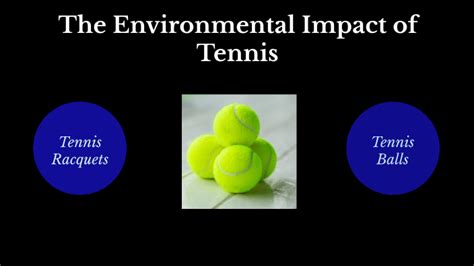Explore the environmental impact of tennis tournaments and discover how organizers, players, and sustainable practices are shaping a greener future in the sport.In an era where environmental sustainability is a pressing concern, the world of tennis is stepping up to reassess its ecological footprint. The Environmental Impact of Tennis Tournaments explores how these grand events, with their high-profile matches and vibrant gatherings, affect our planet. From the use of resources to waste generation, understanding the environmental footprint of these tournaments is crucial. However, positive change is on the horizon as tournament organizers implement innovative strategies to minimize their impact. Players are becoming advocates for environmental awareness, inspiring fans to embrace sustainable practices. This article delves into measuring the benefits of these initiatives and discusses future trends in tennis that could further enhance its commitment to the planet. Join us as we explore this important intersection of sport and sustainability, shedding light on a greener future for tennis.
Understanding The Environmental Footprint Of Tennis Tournaments
The environmental footprint of tennis tournaments encompasses a variety of factors that contribute to ecological degradation. Major tournaments draw huge crowds, resulting in significant resource consumption and waste generation. Understanding this impact is crucial for developing more sustainable practices within the sport.
- Carbon Emissions: Large-scale tournaments often require extensive travel for players, officials, and fans, generating high levels of carbon emissions. Transportation such as flights, buses, and cars contributes heavily to the overall environmental impact.
- Energy Consumption: Facilities use considerable amounts of energy for lighting, heating, and cooling, especially during night matches. If any are powered by non-renewable energy sources, the environmental consequences escalate.
- Waste Generation: The influx of attendees leads to increased waste, from food and beverage containers to promotional materials. Many events struggle with waste management strategies to minimize landfill contributions.
- Water Usage: Maintaining the quality of grass and clay courts during tournaments requires vast amounts of water, raising concerns about water conservation in regions that may already be experiencing scarcity.
- Use of Chemicals: The maintenance of courts often involves pesticides and fertilizers that pose risks to local ecosystems, particularly when runoff occurs.
With an ever-increasing awareness of environmental issues, stakeholders in tennis must prioritize an in-depth examination of these factors. By measuring and understanding the full scope of the environmental footprint, organizers can adopt initiatives aimed at creating a more sustainable future for tennis tournaments.
How Tournament Organizers Are Reducing Environmental Impact
Tournament organizers worldwide are increasingly recognizing their responsibility in mitigating The Environmental impact of tennis events. They are implementing a variety of sustainable practices aimed at reducing waste, conserving resources, and promoting ecological awareness among participants and spectators. Here are some key initiatives:
- Waste Management: Many tournaments are adopting comprehensive recycling programs and encouraging fans to sort waste properly. This includes providing clearly labeled bins for recyclable materials, compost, and trash.
- Energy Efficiency: Organizers are moving towards renewable energy sources, such as solar power, for lighting and other facility needs. By using energy-efficient LED lights and equipment, tournaments can significantly lower their carbon footprint.
- Sustainable Transportation: To minimize carbon emissions associated with travel, many events offer shuttle services and promote public transportation options. Additionally, organizers may encourage carpooling among attendees and staff.
- Eco-friendly Products: The use of biodegradable or recyclable products in food and beverage services is becoming standard. This helps reduce plastic waste significantly during tournaments.
- Water Conservation: Organizers are implementing water-saving irrigation systems for court maintenance and using non-toxic substances to limit the ecological impact on local water sources.
- Community Engagement: Tournaments often collaborate with local environmental organizations to raise awareness and engage fans in sustainability initiatives, creating a broader impact beyond the event itself.
Overall, by incorporating these measures, tournament organizers are taking crucial steps to lessen The Environmental impact of tennis tournaments while setting an example for other sporting events to follow.
The Role Of Players In Promoting Environmental Awareness
Professional tennis players hold significant influence, not just within the sport but also in broader societal issues, including environmental sustainability. Their visibility and engagement can be pivotal in advocating for The Environmental initiatives during tournaments and beyond.
Many players have taken it upon themselves to be vocal advocates for sustainability. For instance, top athletes use their platforms to discuss the importance of eco-friendly practices, such as reducing plastic use and promoting recycling programs. This advocacy can inspire fans and fellow players alike to consider their own environmental impact.
On a more grassroots level, numerous players engage in community outreach programs that focus on educating younger generations about the importance of taking care of the environment. Through clinics, exhibitions, and social media campaigns, they emphasize the role of individual actions in combating climate change and fostering a sustainable future.
Moreover, during tournaments, players can actively participate in sustainability initiatives, such as using biodegradable materials and supporting local environmental charities. Their involvement adds credibility to these programs and encourages more significant support from sponsors and tournament organizers.
The potential for tennis players to promote environmental awareness is vast. By leveraging their fame and showing commitment to The Environmental cause, they can play an essential role in fostering a culture of sustainability in the sport and inspiring fans worldwide to join in these efforts.
Measuring The Environmental Benefits Of Sustainable Practices
Measuring the environmental benefits of sustainable practices in tennis tournaments is crucial to understanding their overall impact. Various methodologies and metrics are employed to quantify the positive changes introduced by eco-friendly initiatives. This can provide insights into how practices can be improved and expanded in the future.
One effective method of evaluation involves the use of carbon footprint analysis. By assessing the total greenhouse gas emissions produced by a tournament, organizers can identify key areas for reduction. These emissions may come from multiple sources, including:
| Source | Typical Emission Contribution |
|---|---|
| Transportation (players, staff, and spectators) | 40% |
| Energy use at venues | 30% |
| Waste generation | 20% |
| Water usage | 10% |
Additionally, tournaments can implement sustainability audits, assessing various dimensions such as resource utilization, waste management practices, and community engagement. By gathering data before and after implementing sustainable practices, organizers can track improvements and measure the effectiveness of initiatives such as:
- Use of renewable energy sources
- Reduction in single-use plastics
- Composting and recycling programs
Furthermore, various organizations also utilize frameworks such as the ISO 20121 standard, which provides guidelines for establishing a sustainable event management system. This standard helps tournaments set goals, monitor progress, and enhance transparency in their operations.
Applying these metrics offers a clearer picture of the positive impact that sustainable practices have on the environmental footprint of tennis tournaments, ultimately leading to more informed decision-making and growing awareness about the environmental responsibilities of the sport.
Future Trends In Tennis And Their Environmental Implications
As tennis evolves, the sport’s leadership recognizes the importance of addressing The Environmental challenges it faces. Here are some key future trends in tennis that could significantly impact its environmental footprint:
- Sustainable Facility Design: Upcoming tennis venues are increasingly incorporating sustainable design principles. This includes energy-efficient lighting, water conservation systems, and the use of renewable energy sources. These facilities aim to become less reliant on fossil fuels and less wasteful in resource consumption.
- Eco-Friendly Equipment: There’s a growing trend towards the use of sustainable materials in tennis equipment. Manufacturers are exploring eco-friendly options for racquets, balls, and apparel, thus reducing their carbon footprint while promoting healthier alternatives.
- Waste Reduction Initiatives: Future tournaments are set to adopt stricter waste management protocols. This includes comprehensive recycling programs and composting initiatives, which encourage fans and players alike to minimize waste during events.
- Digital Innovations: The shift towards digital ticketing and fan engagement platforms is expected to reduce paper waste significantly. Furthermore, advancements in technology could enhance spectator experiences without relying on environmental resources.
- Awareness Campaigns: Tennis organizations are likely to ramp up efforts in promoting environmental awareness among fans and players. Campaigns aimed at educating the public and players about their ecological impact will become a cornerstone of tournament strategies.
- Partnerships for Sustainability: Collaborations with environmental organizations will play a crucial role. By working together, the tennis community can leverage expertise and resources to drive innovative sustainable solutions across the sport.
By embracing these emerging trends, tennis can significantly reduce its environmental impact and lead the way in sustainability. The collective efforts of tournament organizers, players, and fans will be essential in shaping a greener future for the sport and inspiring others in different industries to follow suit.
Frequently Asked Questions
What are the main environmental concerns associated with tennis tournaments?
The main environmental concerns include waste generation, carbon emissions from travel, water usage for maintaining courts and facilities, and the impact on local ecosystems.
How can tennis tournaments reduce their carbon footprint?
Tennis tournaments can reduce their carbon footprint by promoting sustainable transportation, using renewable energy sources, minimizing waste through recycling and composting, and implementing energy-efficient technologies in venues.
What role do fans play in the environmental impact of tennis tournaments?
Fans can contribute positively by choosing sustainable transport options, reducing waste by bringing reusable items, and supporting eco-friendly practices promoted by the tournament organizers.
Are there any tennis tournaments that have successfully implemented sustainable practices?
Yes, several tournaments, such as the US Open and Wimbledon, have adopted sustainable measures, including waste management initiatives and the use of sustainable materials in their operations.
What materials used in tennis tournaments are harmful to the environment?
Materials such as plastic bottles, single-use packaging, and certain types of court surfaces can be harmful to the environment, contributing to pollution and waste.
How does the preparation and construction of tournament venues impact the environment?
The preparation and construction of tournament venues can lead to land degradation, habitat loss, and increased pollution from construction activities, thereby affecting local ecosystems.
What can players do to advocate for a greener tennis industry?
Players can advocate for a greener tennis industry by using their platforms to raise awareness about sustainability, collaborating with organizations focused on environmental conservation, and participating in eco-friendly initiatives.









